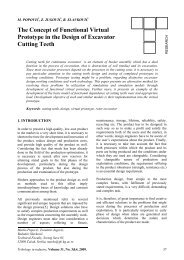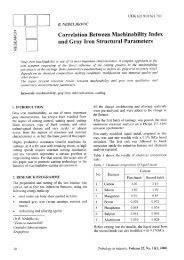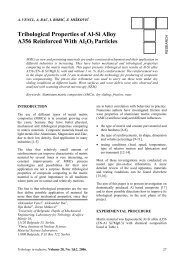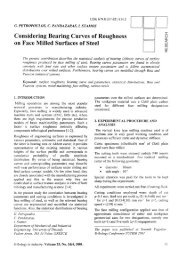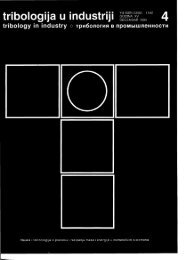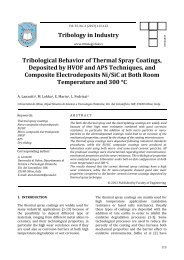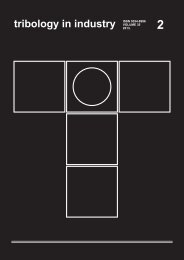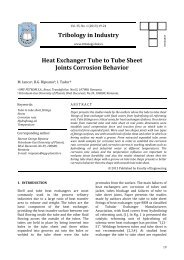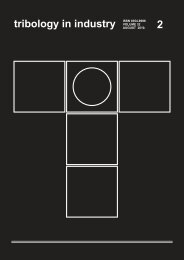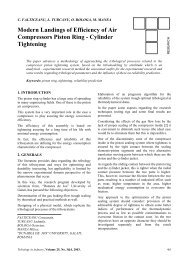(PMMA) Based Bone Cement - Tribology in Industry
(PMMA) Based Bone Cement - Tribology in Industry
(PMMA) Based Bone Cement - Tribology in Industry
Create successful ePaper yourself
Turn your PDF publications into a flip-book with our unique Google optimized e-Paper software.
whereas the force is loaded and unloaded constantlydur<strong>in</strong>g <strong>in</strong>dentation without a pause. Material issubjected to constant load/unload pattern and is notleft to rest, such as <strong>in</strong> case of <strong>in</strong>dentation mode oftest<strong>in</strong>g on creep.Figure 5. Normal force versus penetration depthcurve dur<strong>in</strong>g micro <strong>in</strong>dentationImpr<strong>in</strong>t on bone cement sample after <strong>in</strong>dentationlast<strong>in</strong>g for 300 cycles, is shown <strong>in</strong> Fig. 6. Typicalpattern produced by Vickers <strong>in</strong>dentation is clearlyseen. Detailed view of the left lower angle is shown<strong>in</strong> Fig. 6b. The impr<strong>in</strong>t is well shaped with clearlydeveloped edges and no microcracks around angles.This is <strong>in</strong> consistence with the fact that amorphousmaterials usually present an elastic behavior up tofailure [16]. Permanent deformation occurs due tohigh shear and compressive stresses which are bothpresent <strong>in</strong> highly localized area.Calculated values of hardness H IT and elasticmodulus E IT of bone cement sample after 300cycles obta<strong>in</strong>ed by the <strong>in</strong>dentation tester is shown<strong>in</strong> Table 1.Figure 6. a) Micrograph of the <strong>in</strong>dentation impr<strong>in</strong>ton bone cement after 300 cycles, b) Detail of the<strong>in</strong>dentation impr<strong>in</strong>t on <strong>PMMA</strong> after 300 cycles (leftbottom angle)Table 1. Values of hardness H IT and elasticmodulus E IT of bone cement sample after 300cycles obta<strong>in</strong>ed by the <strong>in</strong>dentation testerValue for <strong>PMMA</strong>sample after 300 cyclesHardness, H IT [MPa] 162.84Elastic modulus, E IT [GPa] 2.74Hardness profile and elasticity profile dur<strong>in</strong>gmulticycl<strong>in</strong>g load<strong>in</strong>g, unload<strong>in</strong>g and reload<strong>in</strong>g areshown <strong>in</strong> Fig. 7. Values given <strong>in</strong> Table 1 areautomatically calculated by the tester accord<strong>in</strong>g toOliver and Pharr approach, by analys<strong>in</strong>g theunload<strong>in</strong>g curves (Fig. 5). It can be clearly seen thatE IT value is rather uniform, whereas hardness hasslightly decreas<strong>in</strong>g trend.Figure 7. Hardness, H IT and elasticity, as a functionof the number of cycles dur<strong>in</strong>g micro <strong>in</strong>dentationLoosen<strong>in</strong>g is recognized as one of the primarysources of total hip replacement failure. One of thema<strong>in</strong> reasons is considered to be fatigue failure ofthe implant-bone cement and bone cement - bone<strong>in</strong>terface. That is the reason why characterization of150<strong>Tribology</strong> <strong>in</strong> <strong>in</strong>dustry, Volume 33, No. 4, 2011.



